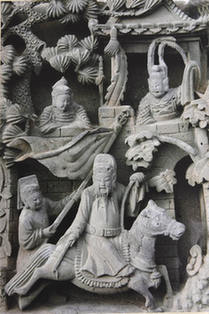| More on the Art of Bricks and Tiles
By HUO JIANYING
THOUGH bricks and tiles are ordinary building materials judged by today's standards, centuries ago commoners mostly built their houses with sun-dried adobes and thatch. Back then, bricks and tiles implied wealth and dignity, in much the same way as marble, steel and glass do today. This was particularly true of bricks and tiles featuring ornamental designs for imperial use. The most representative of these aristocratic building blocks were the bricks and tiles of the Qin and Han dynasties. These were later followed by other ornamental brick carving techniques.
Qin-Han Bricks and Tiles
Kilning bricks and tiles as building materials started in the Zhou Dynasty more than 2,000 years ago. After Emperor Qinshihuang united China and put an end to the chaos of the warring states in 221 B.C., he led the country into a period of economic and cultural development, and a massive construction program. No less than 300 imperial palaces, both large and small, were built around the country, not to mention the 5,000-km Great Wall that stretched from Gansu's Lintao in the west, to the coast of Liaoning Province in the east. After the Han Dynasty succeeded the Qin in 206 B.C., it continued the economic, social and technological progress at an even faster pace. As a result, the scale of kilning and firing technology during these two dynasties surpassed any previous period.
The Qin imperial court built its main projects, such as palaces and mausoleums, using bricks and tiles made of submerged sediment clay. Such bricks were not only solid and durable, but also heavy, so they were also known as "lead bricks."
In the early Han Dynasty, Prime Minister Xiao He was in charge of capital construction in Chang'an. As a townsman and friend of Emperor Liu Bang, Xiao followed him from the beginning of Liu's revolt against Qinshihuang and was his most trusted aide during the fight against the Qin and the establishment of the Han Dynasty. Xiao knew what kind of imperial palace the emperor wanted, and spared no manpower or money in building the Weiyang Palace in order to satisfy Liu's vanity. The bricks and tiles were made of hydro-sifted clay whose fine texture was mixed with metallic elements. Such bricks and tiles were compact and solid and produced a clear ringing sound when tapped.
The newly constructed Weiyang Palace was so magnificent and sumptuous that even the emperor was overwhelmed. He asked Xiao He why he built a palace of such grandeur when the war had not yet been completed and the country not entirely pacified. Xiao answered, "When peace has not come, a plain imperial palace will do. Now that all the Four Seas have come under Your Majesty, how can your power and prestige be embodied without a grandiose imperial palace? And such a palace also spares later generations the trouble of improving it, thus saving future civilian resources." Upon hearing this, Liu Bang commented, "It's not until this moment that I know how worthy an emperor can be."
 |
|
A brick carving depicting a theatrical scene. |
During the Qin and Han dynasties, imperial bricks and tiles were usually carved with exquisite patterns or characters, and some featured details of the names of products and their makers, as well as the year of production. They were both art works and building materials, and were regarded as precious items even at the time they were made. Ordinary people could not use them or even keep them as collectibles.
The national unity and prosperity that characterized the five centuries of the Qin and Han dynasties fostered the first glorious period of ancient Chinese architecture, evidenced by unearthed Qin-Han bricks and tiles that grace today's art and history museums after being buried for thousands of years.
|
